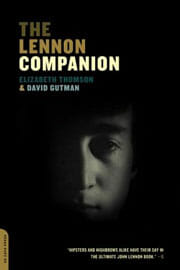
Rock criticism didn’t exist when the pieces composing The Lennon Companion’s first half were initially written, nor was there any precedent whatsoever for the Beatles phenomenon. This early writing reveals those electrifying times, as journalists, essayists and scholars struggled to get a grip on Beatlemania, some sounding as if they’re describing alien creatures newly descended upon the planet.
It didn’t take long for them to identify John Lennon as the ringleader. The other three might have been “lovable moptops,” but Lennon was something different—an acerbically witty, powerfully enigmatic figure who didn’t suffer fools or play by the rules. By authoring In His Own Write, a book of sustained wordplay and whimsical drawings in the manner of Joyce and Thurber, respectively, he polarized literary critics—a situation Tom Wolfe described in his May 1964 Book Week essay, “A Highbrow Under All That Hair?” Three months earlier, Paul Johnson warned readers about “The Menace of Beatlism” in the New Statesman, singling out Ringo Starr, to retrospectively hilarious effect. A Hard Day’s Night, released that August, silenced disbelievers; a stunned Andrew Sarris called the film “the Citizen Kane of jukebox musicals” in his Village Voice review.
Reporter Maureen Cleave’s early 1966 Evening Standard story, about her visit to the mansion Lennon shared with then-wife Cynthia and toddler Julian, portrayed an insatiably curious 26-year-old artist whose mind was “closed round whatever he believes at the time.” By then, Lennon felt trapped by his massive celebrity, prompting the offhand remark to Cleave that “we’re more popular than Jesus now.” The resulting firestorm cemented his status as The Outspoken Beatle. “Musically and personally, Lennon gave the Beatles their edge,” novelist Martin Amis observed immediately after Lennon’s murder on December 8, 1980, in one of five eulogies gathered here; these form a wrenching coda to the collection’s generally downbeat second half, which offers accounts of Lennon’s frequently erratic efforts to achieve equilibrium in his post-Beatles life and work.
The book, originally published in 1987 but out of print in recent years, has a new afterword written by Thomson and Gutman in this updated edition but is otherwise unaltered, as the editors rightly chose to retain their original focus on writings contemporaneous with Lennon’s life and its immediate aftermath. In that regard, The Lennon Companion delivers everything one could ask for—everything, that is, except a happy ending.